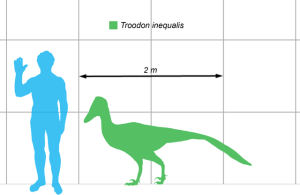Updated on: 28/03/2022
Troodon is an extinct genus of bird-like theropod dinosaur that lived around 76-70 million years ago. Its skeleton remains have been unearthed from several locations in the United States (Montana, Texas, New Mexico and Alaska) and Canada (Alberta).
| Kingdom: | Animalia |
| Phylum: | Chordata |
| Order: | Saurischia |
| Suborder: | Theropoda |
| Family: | Troodontidae |
| Subfamily: | Troodontinae |
| Genus: | Troodon |
| Species: | Troodon formosus (Type Species) T. inequalis |
| Pronunciation: | Tru-oh-don. |
| Name Meaning: | Wounding tooth |
| Geological Time Period: | Campanian to Maastrichtian age, Cretaceous period |
| Size: | Length – 6.5 to 11.5 ft Height – 2.5 to 3 ft |
| Weight: | 100 to 110 lbs |
| Range/Location: | North America |
| Diet: | Carnivore |
| Birth Type (Reproduction): | Eggs |
| Locomotion: | Bipedal |
In 1856, genus Troodon was described as a lizard from a single tooth by American naturalist Joseph Leidy. The tooth was very distinct in nature. It was curved as seen in carnivore species, but it had curved serrations like some of the herbivores. At that time, since there were no skeletal remains, it was hard to determine whether it was really a dinosaur or not. In 1901, citing as dinosaur, it was assigned to the family megalosauridae. However, in 1024, Troodon was assigned as pachycephalosaur; and all genera in the family pachycephalosaurs were classed under troodontidae till 1945 when Troodon was taken out of the group. As a group could not be named after a dinosaur which is not a part of it, the family was renamed as pachycephalosuars after Pachycephalosaurus.
When paleontologists were moving the single Troodon teeth from one family to another, actual fragmentary remains did exist named as Stenonychosaurus first unearthed in 1932. In 1987 Dr. Philip Currie studied both Troodon and Stenonychosaurus materials and found that the only difference between those is the age of the individuals; otherwise they belonged to the same species. Stenonychosaurus (as well as Polydontosaurus and Pectinodon ) was thus described as a junior synonym of Troodon.
After this classification, there have been calls to re-examine all Troodon fossils – as whether the genus should have one species as Troodon fossil remains have been unearthed from several locations with large geographic distances. The specimens are also separated by several million years.

Troodon was a light-weight dinosaur that had a medium-sized skull with a U-shaped snout. The size of the largest found specimen can be compared to those of the Unenlagia and Deinonychus. They possessed a large brain in proportion to their body. They had large, forward facing eyes; a long jaw; and serrated teeth. It had small forearms with three clawed digits. They possessed long, slender hind legs and a long stiff tail. It had a large, retractable sickle-shaped claw bone on the second toe.
Their anatomical features suggest that they were true predators in its habitat. Its fossil finds near northern, and even arctic areas determine that they preferred cooler regions.
They were fast runners and probably led a partly nocturnal lifestyle. Their teeth serrations were more like those of a herbivore. It has been suggested that Troodon’s diet partially included plant materials, or it could be an ‘evolutionary experiment.’ However in general, their food consisted of small mammals, lizards and invertebrates.
They probably reached maturity in 3 – 5 years. Their reproductive strategies were partly similar to both of the crocodiles and birds. Researchers suggested that Troodon produced two eggs at periodic intervals for around ten days, and they incubated them on ground nests.